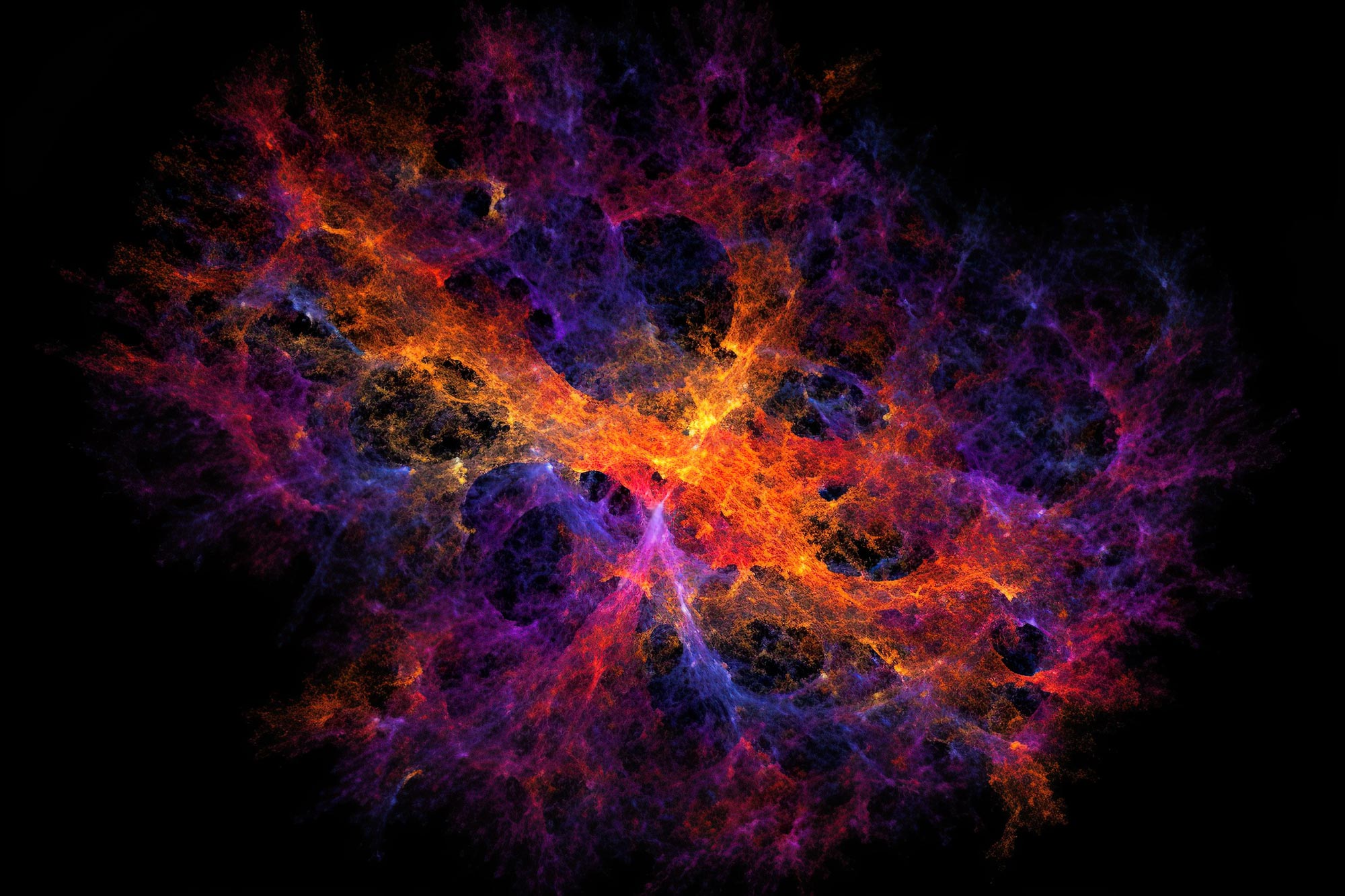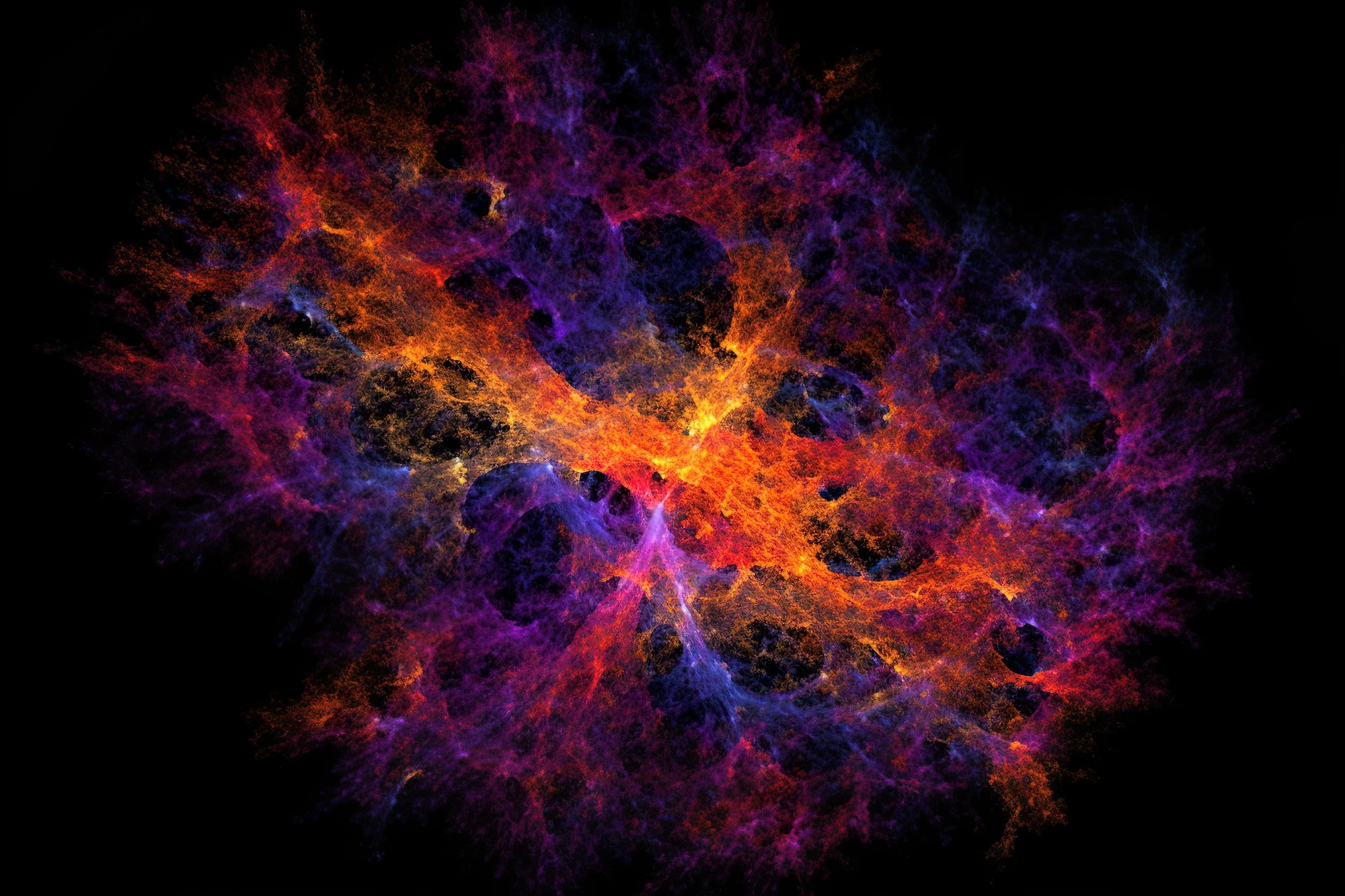

Un team internazionale di astrofisici e cosmologi ha presentato cinque documenti che indicano che il “raggruppamento” (valore S8) della materia oscura dell’universo è 0,76, un numero coerente con altri sondaggi sulla lente gravitazionale ma non con il valore di 0,83 derivato dal fondo cosmico a microonde .
Un team internazionale di scienziati ha utilizzato Advanced Technologies e Hyper Suprime-Cam per studiare i “gruppi” di materia oscura, trovando un valore S8 di 0,76, che contrasta con il valore di 0,83 del fondo cosmico a microonde. Questa discrepanza potrebbe indicare errori di misurazione o un modello cosmologico standard incompleto.
Un team internazionale di astrofisici e cosmologi di vari istituti tra cui il Kavli Institute for Physics and Mathematics of the Universe (Kavli IPMU) ha presentato una serie di cinque documenti di ricerca, che misurano il valore dei “grumi” di materia oscura nell’universo, noti a cosmologi come S.8, di 0,76, che si allinea con i valori trovati da altri sondaggi di lente gravitazionale guardando l’universo relativamente giovane – ma non si allinea con un valore di 0,83 derivato dal fondo cosmico a microonde, che risale alle origini dell’universo quando il l’universo aveva circa 380.000 anni. I loro risultati sono stati caricati come fogli prestampati su arXiv.
Il divario tra questi due valori è piccolo, ma poiché sempre più studi confermano entrambi i valori, non sembra essere casuale. È probabile che ci sia un bug o un errore finora sconosciuto in una di queste due misurazioni o che il modello cosmologico standard sia incompleto in modo interessante.
L’energia oscura e la materia oscura costituiscono il 95% dell’universo che vediamo oggi, ma sappiamo molto poco su cosa siano realmente e su come si siano evolute nel corso della storia dell’universo. I grumi di materia oscura distorcono la luce delle galassie lontane attraverso una debole lente gravitazionale, un fenomeno previsto dalla teoria della relatività generale di Einstein.

Figura 1: Esempio di un’immagine ottenuta con HSC-SSP. Credito: HSC-SSP e progetto NAOJ
“Questa distorsione è un effetto davvero piccolo. La forma di una singola galassia è distorta di una quantità impercettibile”, ha affermato il professor Kavli IPMU Masahiro Takada, ma combinando le misurazioni di milioni di galassie è possibile misurare la distorsione con alta precisione.
Il Modello standard è definito da pochi numeri: il tasso di espansione dell’universo, che è una misura di quanto densa la materia oscura (S8), i contributi relativi dei costituenti dell’universo (materia, materia oscura ed energia oscura), la densità complessiva dell’universo e una quantità tecnica che descrive come l’agglomerazione dell’universo su larga scala è correlata a quella su piccola scala.
I cosmologi sono ansiosi di testare questo modello limitando questi numeri in vari modi, come osservando le fluttuazioni nel fondo cosmico a microonde, modellando la storia dell’espansione dell’universo o misurando il raggruppamento dell’universo in un passato relativamente recente.
Un team guidato da astronomi di Kavli IPMU, Università di Tokyo,[{” attribute=””>Nagoya University, Princeton University, and astronomical communities of Japan and Taiwan, have spent the past year teasing out the secrets of this most elusive material, dark matter, using sophisticated computer simulations and data from the first three years of the Hyper Suprime-Cam survey. The observations from this survey used one of the most powerful astronomical cameras in the world, the Hyper Suprime-Cam (HSC) mounted on the Subaru Telescope on the summit of Maunakea in Hawaii.

Figure 2: The measurement results of S8 parameter from HSC-SSP Year 3 data. The chart shows the results from four different methods, which used different parts of the HSC-SSP Year 3 data or combined the HSC-SSP Year 3 data with other data. For comparison, “Planck CMB” shows the measurement result for S8 from the cosmic microwave background data from the Planck satellite. “Other weak lensing results” shows the results from similar weak lensing measurements based on the Dark Energy Survey (DES) and Kilo-Degree Survey (KiDS) data. Credit: Kavli IPMU
Hiding and uncovering the data
The team performed a “blinded analysis.”
“Scientists are human beings, and they do have preferences. Some would love to really find something fundamentally new, while others might feel comfortable if they find results that look consistent with foreseen results. Scientists have become self-aware enough to know that they will bias themselves, no matter how careful they are, unless they carry out their analysis without allowing themselves to know the results until the end,” said Nagoya University Kobayashi-Maskawa Institute for the Origin of Particles and the Universe (KMI) Associate Professor Hironao Miyatake.
To protect the results from such biases, the HSC team hid their results from themselves and their colleagues for months. The team even added an extra obfuscating layer: they ran their analyses on three different galactic catalogs, one real and two fake with numerical values offset by random values. The analysis team didn’t know which of them was real, so even if someone did accidentally see the values, the team wouldn’t know if the results were based on the real catalog or not.
The team spent a year on the blind analysis. On December 3 2022, the team gathered together on Zoom – one Saturday morning in Japan, Friday evening in Princeton – for the “unblinding.” The team unveiled the data, and ran their plots, immediately they saw it was great according to Takada. “Blinded analysis means you cannot take a peak at the results while running the analysis, which was extremely stressful, but as soon I saw the final result, all of that anxiety flew out of the window,” said Kavli IPMU graduate student Sunao Sugiyama.

Figure 3: An example of a 3D distribution of dark matter derived from HSC-SSP. This map is obtained by using the first year’s data, but the present study examined an area on the sky about three times larger than that. Credit: University of Tokyo/NAOJ
A huge survey with the world’s largest telescope camera
HSC is the largest camera on a telescope of its size in the world. The survey that the research team used covers about 420 square degrees of the sky, about the equivalent of 2000 full moons. It is not a single contiguous chunk of sky, but split among six different pieces, each about the size of a person’s outstretched fist. The 25 million galaxies the researchers surveyed are so distant that instead of seeing these galaxies as they are today, the HSC recorded how they were billions of years ago.
Each of these galaxies glows with the fires of tens of billions of suns, but because they are so far away, they are extremely faint, as much as 25 million times fainter than the faintest stars we can see with the naked eye.
For more on this research, see Measuring Dark Matter With Hyper Suprime-Cam Reveals Discrepancy.
References:
“Hyper Suprime-Cam Year 3 Results: Cosmology from Galaxy Clustering and Weak Lensing with HSC and SDSS using the Emulator Based Halo Model” by Hironao Miyatake, Sunao Sugiyama, Masahiro Takada, Takahiro Nishimichi, Xiangchong Li, Masato Shirasaki, Surhud More, Yosuke Kobayashi, Atsushi J. Nishizawa, Markus M. Rau, Tianqing Zhang, Ryuichi Takahashi, Roohi Dalal, Rachel Mandelbaum, Michael A. Strauss, Takashi Hamana, Masamune Oguri, Ken Osato, Wentao Luo, Arun Kannawadi, Bau-Ching Hsieh, Robert Armstrong, Yutaka Komiyama, Robert H. Lupton, Nate B. Lust, Lauren A. MacArthur, Satoshi Miyazaki, Hitoshi Murayama, Yuki Okura, Paul A. Price, Tomomi Sunayama, Philip J. Tait, Masayuki Tanaka and Shiang-Yu Wang, 3 April 2023, Astrophysics > Cosmology and Nongalactic Astrophysics.
arXiv:2304.00704
“Hyper Suprime-Cam Year 3 Results: Measurements of Clustering of SDSS-BOSS Galaxies, Galaxy-Galaxy Lensing and Cosmic Shear” by Surhud More, Sunao Sugiyama, Hironao Miyatake, Markus Michael Rau, Masato Shirasaki, Xiangchong Li, Atsushi J. Nishizawa, Ken Osato, Tianqing Zhang, Masahiro Takada, Takashi Hamana, Ryuichi Takahashi, Roohi Dalal, Rachel Mandelbaum, Michael A. Strauss, Yosuke Kobayashi, Takahiro Nishimichi, Masamune Oguri, Arun Kannawadi, Robert Armstrong, Yutaka Komiyama, Robert H. Lupton, Nate B. Lust, Satoshi Miyazaki, Hitoshi Murayama, Yuki Okura, Paul A. Price, Philip J. Tait, Masayuki Tanaka and Shiang-Yu Wang, 3 April 2023, Astrophysics > Cosmology and Nongalactic Astrophysics.
arXiv:2304.00703
“Hyper Suprime-Cam Year 3 Results: Cosmology from Galaxy Clustering and Weak Lensing with HSC and SDSS using the Minimal Bias Model” by Sunao Sugiyama, Hironao Miyatake, Surhud More, Xiangchong Li, Masato Shirasaki, Masahiro Takada, Yosuke Kobayashi, Ryuichi Takahashi, Takahiro Nishimichi, Atsushi J. Nishizawa, Markus M. Rau, Tianqing Zhang, Roohi Dalal, Rachel Mandelbaum, Michael A. Strauss, Takashi Hamana, Masamune Oguri, Ken Osato, Arun Kannawadi, Robert Armstrong, Yutaka Komiyama, Robert H. Lupton, Nate B. Lust, Satoshi Miyazaki, Hitoshi Murayama, Yuki Okura, Paul A. Price, Philip J. Tait, Masayuki Tanaka and Shiang-Yu Wang, 3 April 2023, Astrophysics > Cosmology and Nongalactic Astrophysics.
arXiv:2304.00705
“Hyper Suprime-Cam Year 3 Results: Cosmology from Cosmic Shear Power Spectra” by Roohi Dalal, Xiangchong Li, Andrina Nicola, Joe Zuntz, Michael A. Strauss, Sunao Sugiyama, Tianqing Zhang, Markus M. Rau, Rachel Mandelbaum, Masahiro Takada, Surhud More, Hironao Miyatake, Arun Kannawadi, Masato Shirasaki, Takanori Taniguchi, Ryuichi Takahashi, Ken Osato, Takashi Hamana, Masamune Oguri, Atsushi J. Nishizawa, Andrés A. Plazas Malagón, Tomomi Sunayama, David Alonso, Anže Slosar, Robert Armstrong, James Bosch, Yutaka Komiyama, Robert H. Lupton, Nate B. Lust, Lauren A. MacArthur, Satoshi Miyazaki, Hitoshi Murayama, Takahiro Nishimichi, Yuki Okura, Paul A. Price, Philip J. Tait, Masayuki Tanaka and Shiang-Yu Wang, 3 April 2023, Astrophysics > Cosmology and Nongalactic Astrophysics.
arXiv:2304.00701
“Hyper Suprime-Cam Year 3 Results: Cosmology from Cosmic Shear Two-point Correlation Functions” by Xiangchong Li, Tianqing Zhang, Sunao Sugiyama, Roohi Dalal, Markus M. Rau, Rachel Mandelbaum, Masahiro Takada, Surhud More, Michael A. Strauss, Hironao Miyatake, Masato Shirasaki, Takashi Hamana, Masamune Oguri, Wentao Luo, Atsushi J. Nishizawa, Ryuichi Takahashi, Andrina Nicola, Ken Osato, Arun Kannawadi, Tomomi Sunayama, Robert Armstrong, Yutaka Komiyama, Robert H. Lupton, Nate B. Lust, Satoshi Miyazaki, Hitoshi Murayama, Takahiro Nishimichi, Yuki Okura, Paul A. Price, Philip J. Tait, Masayuki Tanaka, Shiang-Yu Wang, 3 April 2023, Astrophysics > Cosmology and Nongalactic Astrophysics.
arXiv:2304.00702

“Sottilmente affascinante social mediaholic. Pioniere della musica. Amante di Twitter. Ninja zombie. Nerd del caffè.”





More Stories
Un decesso per il virus del Nilo occidentale è stato segnalato nella contea di Santa Clara – NBC Bay Area
Ultime notizie sugli astronauti della NASA: aggiornamento sull’equipaggio del Boeing Starliner bloccato nello spazio
Ci sono oceani sotto la superficie di Marte? La sonda InSight della NASA rivela un enorme serbatoio di acqua liquida